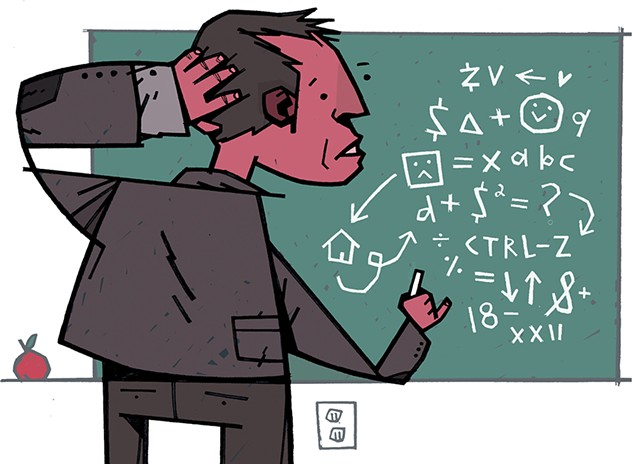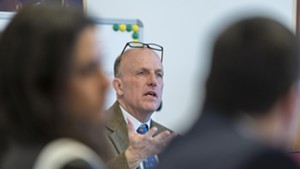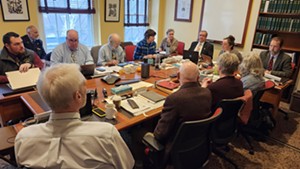
- Thom Glick
School districts begin drafting their budgets long before voters weigh in on Town Meeting Day. This year, despite plenty of preparation, administrators say unexpected complications mean those budgets are at risk of being defeated at the polls on March 5.
In South Burlington, for instance, administrators worked for months on a $69 million proposed budget — around $6.5 million more than this year's, largely due to nonnegotiable factors including the loss of federal pandemic aid, inflation, and increasing employee health insurance costs and wages. Because of a temporary provision in a new education funding law, that budget would have increased South Burlington homeowners' property tax rate by just 5 percent — or $295 a year more for a home worth $438,000, the city's average home value.
Then, on January 2, the state released the common level of appraisal for each town. The CLA, which is calculated by reviewing three years of home sales data, is a tool meant to ensure that each town is contributing its fair share to Vermont's education fund. If a town's CLA is below 100 percent — meaning homes are assessed at less than their actual value — property tax rates are increased to reflect the difference.
Despite a citywide reappraisal in 2021, South Burlington's CLA dropped 11 percentage points from last year, to 82 percent — an indication of its booming real estate market. Applying that number to the education funding formula, South Burlington residents are now looking at an 18.3 percent tax hike — an increase of $1,080 a year for a typical home.
Communities across the state are grappling with similar tax increases. Rising costs, the use of education-fund surpluses to buy down tax rates in recent years and out-of-whack CLAs are partly to blame. But so is Act 127, a bill passed last year that was meant to increase equity in school funding. It has led to unforeseen consequences that threaten to harm districts, including the more impoverished ones it was meant to aid. That's left Vermont school systems — already confronted with dire facilities problems and the post-pandemic mental health needs of students — facing their most difficult budget season in recent memory.
With Town Meeting Day just five weeks away, districts are calling on legislators to find a fix. They are also wrestling with how to explain the tax increase to voters, many of whom are already stretched thin by the state's high cost of living and inflation and don't understand how Vermont's convoluted education funding system works.
"I've never seen a situation quite like this," said Jeff Francis, executive director of the Vermont Superintendents Association. "The pressures that school districts are experiencing are greater than ever before."
Elaine Collins, superintendent of North Country Supervisory Union, put it more bluntly at a legislative hearing last week.
"It is a miracle if we're going to pass school budgets this year," Collins said. "It's a mess. And it's a mess, I think, not of the schools' making."
If voters reject their school budget on Town Meeting Day and don't approve an amended budget by July 1, districts would be mandated to level-fund and use their current year budget figures. Nonnegotiable rising costs related to teachers' salaries, health insurance and inflation would force districts to cut what they actually control: staffing and programs.
In South Burlington, for example, reverting to this year's budget would mean slashing millions from the proposed one. Even then, South Burlington homeowners would still end up with a 16.5 percent tax increase — saving the average homeowner just $108 for the year as compared to the proposed budget. To achieve that, the district, one of few in the state that has a growing student population, would have to consider cuts in the arts, foreign languages, advanced placement classes, athletics, clubs and transportation, superintendent Violet Nichols said.
At a January school board meeting, the district's finance director, Tim Jarvis, referred to that scenario as "Armageddon."
State aid and how it's calculated is at the heart of the problem. All school taxes — whether from homes, commercial properties, sales, rooms and meals, or lottery — go into the state education fund. The education fund, in turn, sends districts money to cover the costs of voter-approved spending plans.
But several factors besides school districts' spending influence the property tax rate that homeowners ultimately pay. Those include districts' equalized pupil counts, a figure that gives extra weight to students with characteristics that make them more costly to educate, and the common level of appraisal, which has gone down this year in most Vermont towns.
In 2022, the legislature passed Act 127, a law intended to give more weight in the equalized pupil count to students living in poverty, in rural areas and who are English language learners. The change was meant to enable historically disadvantaged districts to offer more services without raising property taxes.
To soften the blow for more affluent and homogeneous districts, Act 127 included a provision that capped homestead property tax rate increases at 5 percent for the next five years, as long as districts did not increase per-pupil spending by more than 10 percent year over year.
South Burlington, a loser in the Act 127 equation, realized that with the law's tax cap, the district could get close to the 10 percent threshold without direct property tax consequences. The district capitalized by adding $2 million for a construction reserve fund in what is now a $71 million budget proposal. School board members believed voters would be more likely to approve the hefty 18.7 percent property tax increase if the district showed it was setting aside money for needed capital improvements.
Similarly, Mount Mansfield Unified Union School District, which is also being negatively impacted by Act 127, added an extra $5.7 million to next year's budget for improvements to its aging buildings, grounds and infrastructure — without having to hike taxes.
"We believe it is very important for [Mount Mansfield] to optimize this limited and once-in-a-generation opportunity," school board members wrote in a letter to the community earlier this month.
Rep. Emilie Kornheiser (D-Brattleboro), who chairs the House Ways and Means Committee and helped draft Act 127, said that, on its face, it is "a perfectly reasonable decision" for a district to budget for outstanding facilities issues. Many school buildings in Vermont need major repairs, and the state hasn't offered school construction aid for more than 15 years.
But, Kornheiser said, the problem is that "if 50 districts do that, it's an extra $100 million in education spending." That would require the education fund to raise more money from districts that aren't using the cap provision, driving up taxes in communities that were meant to benefit from Act 127.
Kornheiser and Sen. Ann Cummings (D-Washington), chair of the Senate Finance Committee, wrote to school districts on January 19, expressing their concern about the way some were taking advantage of the 5 percent tax cap. All districts using the provision, the legislators wrote, would be required to present their budgets to the state for review.
"If districts act solely in their own rational self-interest, these costs will be picked up by property taxes in neighboring towns," the letter said.
Those towns include Winooski, one of the districts that was supposed to benefit from Act 127 due to its large number of multilingual and low-income students. Administrators there believed they could beef up services without raising taxes. But Winooski school board members Robert Millar and Nicole Mace warned legislators in a recent letter that as more districts use the cap provision to set money aside for capital improvements, Winooski could lose its advantage.
"We are hoping the Legislature will take up this matter with the urgency that it requires now that it is clear that the transition provisions of Act 127 are subverting the very policy objectives Act 127 aims to achieve," Millar and Mace wrote.
North Country superintendent Collins, whose relatively poor, rural district was also poised to increase spending without a tax hike, expressed similar concerns. Collins told lawmakers that in December, district officials projected tax rates would decline significantly. But after receiving lower-than-expected CLA numbers earlier this month, in conjunction with the ballooning budgets of other districts whose property taxes are capped, homeowners in the Northeast Kingdom district could face an 18 percent average tax rate increase.
In his budget address last week, Gov. Phil Scott said Vermonters can't afford the projected property tax increases and gave broad suggestions for how the state might tackle the issue, including increasing class sizes, consolidating schools, addressing steeply rising health care and retirement costs for educators, and even rethinking the education funding formula. Scott said he would work to find solutions but needed the legislature to be "a willing partner."
His suggestions, though, are for long-term fixes — cold comfort to school districts that are bracing for Town Meeting Day.
Last Thursday, legislators heard from school and state officials about the quandary. Jake Feldman, a senior fiscal analyst with the Department of Taxes, said the CLA was not responsible for driving up taxes.
He pointed to "unprecedented" increases in anticipated education spending, as well as one-time funds the state used in previous years to buy down property tax rates. That has created a "tax rate trough that you need to then climb out of."
But, in an indication of just how confounding Vermont's ed finance system is, that's not how many districts see it. Multiple administrators cited dropping CLA numbers as one of the main factors affecting their projected tax increases.
Many also took aim at Act 127, which, some say, has incentivized additional spending because of its vague language around the cap provision. If the legislature is planning to change the rules around the legislation, they said, it needs to tell districts as soon as possible.
At the core of much of the testimony was a palpable fear that, if nothing changes, education costs will continue to soar, taxpayers will not be able to bear the burden, and students and families will suffer the consequences.
"As school boards, we need explicit direction from the state on the following: Is it the will of the legislature and the governor to dramatically scale back public education as we know it in Vermont?" Essex Westford school board chair Robert Carpenter testified. "Due to Act 127 and the CLA, we must weigh laying off hundreds of teachers and staff who are middle-class community members or pass the burden ... to our taxpayers.
"Either way," he added, "the fallout will alter the fabric of our communities."
At a joint hearing on Tuesday of the House Ways and Means and Education committees, legislators acknowledged the intense reaction they'd heard from school officials. The lawmakers said they would alter the 5 percent cap provision and other elements of Act 127 "this year" — but did not specify how or when, exactly.
Ways and Means chair Kornheiser acknowledged that the law had proved problematic.
"I think [school districts] are absolutely ... following the language of this law," Kornheiser said, "and what I've also seen is it's behaving very differently than we imagined it would when we passed it."













Comments
Comments are closed.
From 2014-2020, Seven Days allowed readers to comment on all stories posted on our website. While we've appreciated the suggestions and insights, right now Seven Days is prioritizing our core mission — producing high-quality, responsible local journalism — over moderating online debates between readers.
To criticize, correct or praise our reporting, please send us a letter to the editor or send us a tip. We’ll check it out and report the results.
Online comments may return when we have better tech tools for managing them. Thanks for reading.